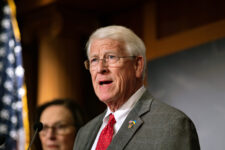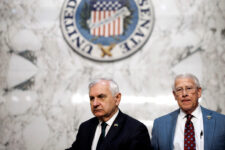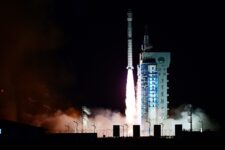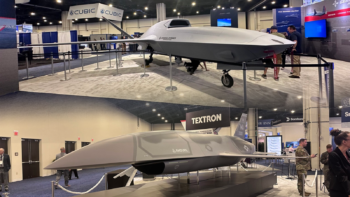
Next Generation Overhead Persistent Infrared missile warning/tracking constellation (Raytheon Intelligence & Space illustration)
WASHINGTON — The Defense Department’s fiscal 2024 budget request is more than likely to include yet another giant leap for the Space Force’s budget, perhaps by as much as $3 billion to $6 billion more than the $26.3 billion appropriated this year, according to an analysis by Mike Tierney, legislative affairs head for the National Security Space Association. But the key question will be whether Congress is satisfied with the service’s actions to untangle a bevy of management and oversight issues troubling lawmakers.
“Congress is certainly being supportive across the board providing additional funding, but I think it’s important to note that their patience seems to be running thin, to a certain extent, with the management of the overall Space Force portfolio, from a budget and accounting, and organization and management standpoint,” Tierney said on Thursday.
Tierney, a long-time space budget guru, spoke during an NSSA webinar where he provided an in-depth look at this year’s Space Force budget compared with the past two years, including a number of charts [PDF].
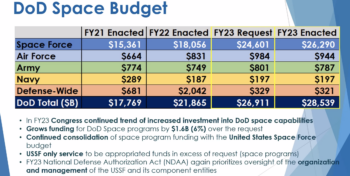 Perhaps most striking, his analysis shows the steep climb in the amount of the service’s classified budget, which has jumped from $3.7 billion in FY21 to $6.6 billion in FY23. This is not, he stressed, counting funding for the National Reconnaissance Office that for DoD accounting reasons flows through the Space Force.
Perhaps most striking, his analysis shows the steep climb in the amount of the service’s classified budget, which has jumped from $3.7 billion in FY21 to $6.6 billion in FY23. This is not, he stressed, counting funding for the National Reconnaissance Office that for DoD accounting reasons flows through the Space Force.
“This is a place where Congress has consistently and, frankly the department, has consistently increased investment year over year,” Tierney said, explaining that classified basket “presumably” includes a number of different research and development initiatives. “To be clear, this is really a leading indicator … that allows us to kind of see that public trend [in the Space Force budget request], and, as you can see, it’s growing annually, and Congress is continuing to plus up the classified account. That doesn’t seem to be drying up anytime soon.”
To the joy of space budget nerds, and not doubt many congressional staff members, Tierney broke down planned Space Force FY23 spending, as approved by the omnibus appropriations act signed Dec. 20 by President Joe Biden, along the service’s budget “portfolios.” This is something that the service’s budget request does not do, and highlights what areas of space acquisition are being prioritized.
For example, the “Space Sensing” portfolio, which includes development of the service’s multi-billion missile warning/tracking satellite programs such as the Next Generation Overhead Persistent Infrared constellation, is dollar-wise the biggest spending basket in FY23, besides classified programs, at $4.26 billion.
But the portfolios that have increased the most over the past two years percentage-wise are that of the Space Development Agency, with a FY23 budget of almost $3 billion that represents a 508% jump over FY21; and the Assured Access to Space (i.e. launch) portfolio, which increased by 232% from its FY21 level to $1.5 billion in FY23.
FY24: Bigger Request, More Congressional Scrutiny
Tierney said that despite continuing to bolster the Space Force’s budget, the House and Senate Armed Services and Appropriations Committees over the past year have become increasingly concerned by what they see as a lack of clarity in service management and DoD oversight, of everything from long-term budget planning to policy to strategy development to mission prioritization. The FY23 National Defense Authorization Act, as well as the defense appropriations act, included a plethora of language either seeking to guide service actions, demanding greater transparency and/or requiring Pentagon and Space Force leaders to explain various decisions (or in many cases, the lack thereof.)
Congressional restiveness about those issues, he warned, is something that may come back to bite the Space Force during the FY24 oversight and budget cycle.
For example, Tierney said, Congress is upset about the fact that the Space Force’s acquisition plans outstrip DoD’s expected five-year future year defense program (FYDP) funding levels.
“There’s a very, very condemning provision in the [FY23] appropriations bill that basically says, ‘We’re not seeing the rigor that is needed to account for what it is that you’re saying that you’re going to do,’ because the Congress is looking at the department’s FYDP, the future year budget, and seeing that it doesn’t match the investments that [the Space Force is] proposing,” he said. “The Congress sees flattening or declining budgets over the horizon, which is inconsistent with what is logically needed and what [the Space Force] is expecting to fund these architectures that the [Space Warfighting Analysis Center] is promulgating.”
Thus, Tierney said, lawmakers have mandated a series of reporting requirements that require the DoD and the service to “show their work” with a briefing “on the projected cost, affordability and executability of the full portfolio of programs and activities funded in the Space Force accounts.”
“It really is a little bit of a shot across the bow,” he said.
Congress also is likely to put a beady eye to the service’s FY24 request to see if the rhetoric from leadership about a Space Force “pivot” towards leaning more heavily on widely available commercial space capabilities such as satellite communications (SATCOM) — rather than using defense contractors to build bespoke satellites — is substantiated with realistic funding, he said.
“This is one area that is one of my greatest disappointments, because it feels like everybody is aligned, where you have senior leaders inside of the Department of Defense and Space Force are talking, and Space Command as well, about the need for greater use of commercial capabilities for the warfighter. You’ve got industry ready and willing and waiting for those opportunities. And you’ve got Congress, who has been long beating the drum about specific areas where commercial capabilities can provide added value, whether it’s small launch or … commercial space domain awareness capabilities, or commercial SATCOM, for that matter,” he said.
“So, it’s a little bit frustrating to me in the sense that there’s some low hanging fruit, and easy wins for DoD and USSF to start showing those pivots,” Tierney added. “I would love to say that I’m expecting it when we see the request. I’ll certainly be looking for it. But I think it’s one of those areas where there continues to be a gap.”
From Boeing’s struggles to inflation relief funds: 5 industry stories from 2024
Making a year-end list in which she forces references to Taylor Swift songs for no reason has basically become reporter Valerie Insinna’s favorite Christmas tradition.


